|
|
Another music star is interested in going to space. US Weekly reported Wednesday that pop singer Lady Gaga, perhaps known as much for her creative wardrobe as for her music, would be flying on Virgin Galactic in 2015 to perform a song. The singer—legally known as Stefani Joanne Angelina Germanotta—would fly as part of festival called “Zero G Colony” reportedly planned for early 2015 at Spaceport America in New Mexico that will feature “world-class entertainment and cutting-edge technology.” Lady Gaga and her “glam squad” would fly on SpaceShipTwo and perform one song during their brief time in space.
The US Weekly article includes the claim that Lady Gaga “has to do a month of vocal training because of the atmosphere,” an odd statement since the cabin of SpaceShipTwo will be pressurized, presumably at least to levels found in commercial jetliners. The overall article has been widely re-reported, with little additional information; one exception is E! Online, which reports that the Zero G Colony event will be a “high-concept ground event music festival” that includes “futuristic attractions.” (Nothing is said about the logistics of holding a music festival at the remote spaceport, particularly during the winter, when it can be quite chilly in the New Mexican desert; in addition, the acoustics inside the Virgin Galactic Gateway to Space hangar are, based on personal experience, lousy.)
There’s been no official announcement from Virgin Galactic or other participants in the reported flight, beyond a cryptic tweet from Lady Gaga herself:
A follow-up tweet from the singer suggests more details will come out Sunday, tied to the release of her latest album, ARTPOP:
Much of the coverage that has been published about the report plays up claims that Lady Gaga would become the first recording artist to perform in space. In fact, though, she joins a number of other individuals and groups seeking to be the first to perform in space. In 2011, British group Muse said they were interested in performing on a Virgin Galactic flight. A year later, there were reports the musical power couple of Jay-Z and Beyoncé were considering filming a music video on a Virgin Galactic flight. And, just last month, pop star Rihanna reportedly purchased three Virgin Galactic tickets, although there was no talk of her performing on the flight (the extra tickets would go to her brother and a very lucky bodyguard.)
In any event, Lady Gaga (or Jay-Z and Beyoncé, or Muse, etc.) could become the first recording artist to perform in space, but certainly not the first musician. A number of astronauts have, over the years, demonstrated their musical talents while in space. In 2011 NASA astronaut Cady Coleman performed a flute duet with Ian Anderson (of Jethro Tull fame) while she was on the ISS. (Anderson was earthbound.) Earlier this year, Canadian astronaut Chris Hadfield performed David Bowie’s “Space Oddity” near the end of this stint on the space station. Hadfield is not a professional musician, but his cover of “Space Oddity” might sound better to many ears than the collected works of Lady Gaga.
Blue Origin is best known for its work developing suborbital and orbital reusable spacecraft (well, that, and its infamous secrecy about that work.) But the company at least once had interest in a different topic, according to an unusual source: planetary defense.
That’s the claim of the obituary of William Wright Kuhn, a mathematician and consultant who passed away last month. The obituary, published Tuesday in the Philadelphia Daily News, states that Kuhn worked as a consultant for Blue Origin from 1999 to 2006. (The start date is one year before the company was formally incorporated.) “His primary work was to help develop a sunlight-powered spacecraft whose purpose was to prevent asteroids or comets from hitting Earth,” the obituary claims, adding that, besides its space transportation work, Blue Origin “is also working on the problem of Earth being bombarded by astronomical drifters bent on destruction.”
“His expertise in math-physics was invaluable,” adds a separate obituary of Kuhn published by his funeral home in South Carolina. “In addition, using his technical and management skills, he was key in helping to identify and manage lines of promising research and the scientists performing the work.”
This appears to be the first time that Blue Origin has been publicly linked to any kind of planetary defense work. However, at least in the early years of the company, Blue Origin did cast a wide net in studying advanced technologies. In The Everything Store: Jeff Bezos and the Age of Amazon, the new book about the founder of Amazon.com and Blue Origin, author Brad Stone noted that, when he first wrote about the company for Newsweeek a decade ago (the first public account of Blue Origin), the company “was also funding forward-looking research into new propulsion systems, like wave rotors and rockets powered by ground-based lasers.” Spacecraft for planetary defense might also fit into that “forward-looking research” category.
Speaking late Sunday at the New Horizons in Science conference, a meeting of science writers at the University of Florida, Virgin Galactic CEO George Whitesides did not make much news for those who have been following the company’s suborbital vehicle developments. (Full video of the talk, which was webcast live, is above.) Perhaps the most newsworthy development was the schedule for the company’s next powered SpaceShipTwo flight. “We’re about a month away from our next flight, maybe a little less, depending on how things go,” he said. It has been exactly two months since the last powered SpaceShipTwo flight, on September 5; that flight was the first since the inaugural powered test flight on April 29. (Last month, at the ISPCS conference in New Mexico, Virgin Galactic president Steve Isakowitz said the next flight would take place “very soon,” but was not more specific.)
Whitesides’s speech was primarily an overview of Virgin Galactic to an audience that may not follow the company that closely. His presentation ended with something of a request for the assembled media to put projects like his in context. “We face a challenge in the Western world right now, and that is an aversion to risky projects,” he said, calling this risk aversion a problem. “We need a capacity to engage in audacious, bold, and risky projects in our society.” The media, he said, have a responsibility to “contextualize” such efforts and the resulting perceptions by the public and policymakers.
“I’m not arguing that that means the press should cast an uncritical eye towards such projects,” he said, counting Virgin Galactic’s SpaceShipTwo as one example. “But, in cases like, for example, flight tests, you all play a critical role in explaining to the information consumer what’s really going on, and how people should think about it… We’re doing flight tests now. Things will go wrong in flight tests, I guarantee you… The point of flight tests is to figure out where things go wrong and to fix them before you put them into commercial service.”
The questions that Whitesides got after his presentation demonstrated that the audience already had a wide range of views about his company and human spaceflight in general. One person was critical of human spaceflight, saying that “scientific return” of human spaceflight paled in comparison to robotic missions. “With all the problems we have on Earth, why are we creating amusement park rides in space for rich people?” he asked.
“We are privately funded,” Whitesides responded, “so, it’s not up to you. You have a right to talk about your tax dollars, because it’s your tax dollars. This is not your money, so you don’t have a right to say that it shouldn’t be done.”
At something close to the other extreme was another audience member who asked if Virgin Galactic would be offering free SpaceShipTwo flights to the media. Whitesides said they were considering something along those lines. “We’ve been thinking about what to do with those open seats” that are created by last-minute cancellations, he said. Some would be filled by employees, but “there may well be an opportunity for certain media to come along.” In that case, he said they would probably train some select media in advance and have them report to the spaceport on a couple days’ notice when an opening appears.
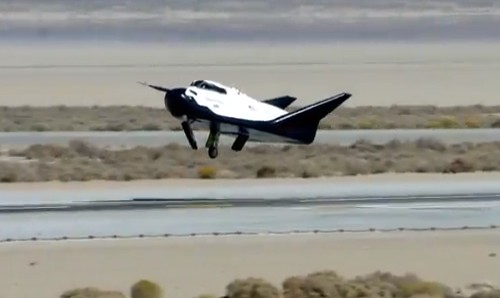 SNC’s Dream Chaser engineering test article (ETA) moments before landing at Edwards Air Force Base on October 26. The image is a still from a video released by the company on October 29; the video cuts off before the actual landing but the missing left main gear is evident in the video. (credit: SNC) When Sierra Nevada Corporation (SNC) confirmed reports of an “anomaly” during the landing of its Dream Chaser engineering test article (ETA) at the end of its first free flight Saturday, some people assumed the worst, given the lack of details about the incident. On Tuesday, an SNC executive said not only were things not as bad as feared, the flight may actually accelerate the company’s development of Dream Chaser.
“The 99 percent of the flight that we really wanted to test… all that was a 100-percent success,” SNC corporate vice president Mark Sirangelo said in a teleconference with reporters Tuesday morning. He was referring to the phases of the flight leading up to the landing, including the descent and approach to the runway at Edwards Air Force Base in California. “In fact, we probably performed better than the test standards were meant to be. We deem this to be a significant success.”
As Sirangelo recounted to reporters, the flight was going well up until landing. The Dream Chaser ETA was carried aloft to an altitude of 3,800 meters (12,500 feet) by a helicopter and then released. The ETA initially flew at a steep down angle, about 50 degrees, as planned to pick up velocity, then flared up as it approached the runway at Edwards. The automated vehicle aligned itself with the runway’s centerline and descended to landing.
The problem with the left landing gear—the front skid and the right gear deployed normally—appears to be a mechanical issue with the gear. “The commands were given, and the gear was commanded to come down,” Sirangelo said. “The left main gear had a problem and was hung up.” The vehicle tried to compensate for the missing gear upon landing, but eventually skidded off the runway.
The Dream Chaser ETA was damaged, but not seriously. “We believe it to be repairable and flyable,” Sirangelo said. “The entire interior of the vehicle—the pressure vessel, as we call it, or crew compartment—was completely untouched by the incident. All systems were fully operational. There’s no damage whatsoever to any critical components of the vehicle.” SNC is investigating the landing gear failure, he said, adding that the ETA used landing gear taken from an F-5 aircraft and are not the same design that the company would use for later versions of the Dream Chaser.
That said, the company hasn’t said much about exactly what was damaged with the vehicle beyond the fact that no critical components were affected. A six-inch (15-centimeter) protective layer surrounding the composite shell of the vehicle, simulating the thermal protection system the orbital version of Dream Chaser will have, “effectively cushioned” the vehicle as it slid off the runway, Sirangelo said. The company has not released any photos or video of that skid; a video the company released Tuesday cuts off just before landing, although it does show the landing gear deployment and thus the missing left gear. Sirangelo said in an email exchange later Tuesday that he couldn’t say when additional photos or video would be released.
Despite the failed gear, Sirangelo said the flight was still successful enough that it should satisfy the requirements of the test. The test was the final milestone in the company’s Commercial Crew Development 2 (CCDev-2) agreement with NASA; the company is already well on its way through completing the follow-on Commercial Crew Integrated Capability (CCiCap) award. “We believe that we satisfied the requirements” of the CCDev-2 milestone, he said. “NASA needs to review and [is] expected to do that within 30 days.”
Sirangelo emphasized that the key part of the test was testing the flight characteristics of the Dream Chaser and verifying them against models, noting that the test was the first flight of lifting body “of this type” since the 1970s. All of the data to date suggests the vehicle performed as predicted, if not better, which may mean that a second drop test originally planned for the ETA may not be needed.
“This vehicle was only meant to have two autonomous flights anyway before it came back to our headquarters to be reworked for piloted flight, so we’re determining whether or not we actually received enough data from this flight” to skip that second flight and go directly into those modifications, he said.
That decision will be made in a few weeks, he said, adding that if they do decide to skip the second test flight, they will actually be accelerating their testing despite the landing incident. “If we were able to get all the flight data we were expecting to get, we might actually be able to bring the vehicle back earlier and get it ready for its next flight, and that might actually, in some strange way, accelerate the program.”
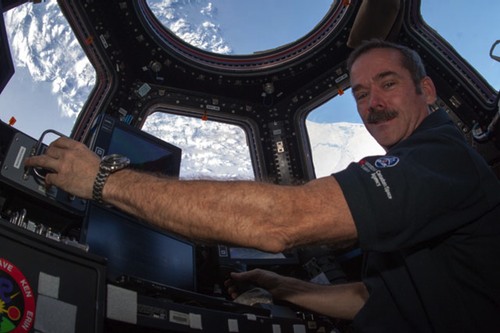 Chris Hadfield on the ISS in early 2013. In an interview, he wonders if some Virgin Galactic customers know about the limited spaceflight experience they’ll get. (credit: NASA) Canadian astronaut Chris Hadfield, who gained fame earlier this year for his social media outreach while serving on the International Space Station, is doing some interviews with more mainstream media in advance of the publication of his book, An Astronaut’s Guide To Life On Earth. In an interview with UK newspaper The Guardian, he’s asked what he thinks about suborbital space tourism ventures such as Virgin Galactic. He offers a qualified endorsement of such flights.
“I’m all for the idea. I commend him for it. But it’s not much of a space flight,” he said, referring to Sir Richard Branson. He believes that some celebrity customers (the example given by The Guardian of Paris Hilton) might be disappointed about the relatively brief flight. “I’m not sure she knows what she’s paying for. She may think she’s going to … see the universe and stars whipping by. None of that’s happening. They’re just going to go up and fall back down again… They’ll get a few minutes of weightlessness, and they’ll see the black of the universe. And they’ll see the curve of the Earth and the horizon, because they’ll be above the air. But whether that’ll be enough for the quarter-million-dollar price tag? I don’t know.”
He also note the risks inherent in spaceflight. “Eventually they’ll crash one. Because it’s hard. They’re discovering how hard,” he said, noting the years of delays Virgin Galactic, which originally proposed, nine years ago, to begin commercial flights in late 2007. However, he’s not rooting against Virgin. “I hope he succeeds. The more people who can see the world this way, the better off we are.”
 Dream Chaser performs a captive carry flight above Edwards AFB in California on Thursday, suspended under a helicopter. (credit: NASA/Carla Thomas) The engineering test article of Sierra Nevada Corporation’s Dream Chaser commercial crew vehicle made its first free flight on Saturday at Edwards Air Force Base in California on Saturday, but suffered the failure of a landing gear upon landing.
According to an official SNC statement, the vehicle released from an Erickson Air-Crane helicopter at 11:10 am PDT (2:10 pm, 1810 GMT) Saturday, gliding back from an unspecified altitude to a runway landing at Edwards. That glide flight, the first for Dream Chaser after a series of taxi and captive carry tests, went well until Dream Chaser landed on the centerline of runway 22L at Edwards less than a minute after release. An “anomaly” with the left gear then occurred, but neither SNC nor NASA offered additional details. A statement on the NASA Dryden website said no one was injured and “damage to property is being assessed.”
No other information, nor any photos or video, of the flight test have been released by NASA or SNC, making it difficult to determine the extent of damage to the test article. A report by NASASpaceFlight.com, citing unnamed sources, said the vehicle flipped over on the runway after suffering a mechanical failure of the gear.
This is not the first time an experimental spaceplane has suffered landing gear problems. Nearly ten years ago, SpaceShipOne (SS1) suffered a failure of its left landing gear during a hard landing at Mojave Airport after its first powered test flight. “A nominal landing pattern was flown, but touchdown caused the left main gear to collapse and the vehicle rolled to a stop off the runway in the soft sand,” the test log entry for that flight explains. The vehicle suffered only minor damage and was flying again in early March 2004.
SNC added a philosophical note to the end of their press release about the flight, a reminder that these are, after all, test flights where things can and do go wrong: “As with any space flight test program, there will be anomalies that we can learn from, allowing us to improve our vehicle and accelerate our rate of progress.”
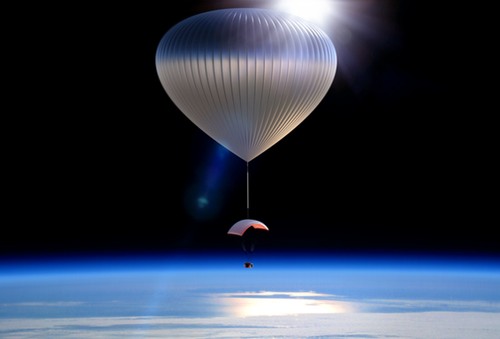 Illustration of World View’s balloon in the upper atmosphere, with a capsule carrying up to eight people suspended under a parafoil. (credit: World View Enterprises) A new company featuring some familiar faces is planning to develop a high altitude balloon system that will carry passengers to the edge of space on multi-hour flights, but be treated as a launch vehicle by federal regulators.
Tucson-based World View Enterprises is formally unveiling its plans today for developing a system that will transport eight people in a pressurized capsule up to an altitude of 30 kilometers (98,400 feet), where they will remain for up to several hours before descending to Earth under a parafoil. The company expects to begin these flights no earlier than 2016, charging $75,000 a ticket, considerably less than rocket-powered suborbital space tourism ventures like Virgin Galactic and XCOR Aerospace.
The announcement is tied to the expected publication today by the FAA of a determination that World View’s vehicle is considered a launch vehicle, and thus would be regulated by the FAA’s Office of Commercial Space Transportation (AST) and not the aviation side of the FAA. That determination means that World View flights would take place under a launch license, just like commercial suborbital and orbital rocket launches.
That determination is based on the FAA’s interpretation of the definition of a launch vehicle under federal law (specifically, 51 USC § 50902). The law defines a launch vehicle as being either “a vehicle built to operate in, or place a payload or human beings in, outer space” or “a suborbital rocket.” (The term “outer space” is not explicitly defined in federal law.) The second definition doesn’t apply to World View, since it is not a rocket, but FAA lawyers noted that the capsule will be designed to operate as if it was in orbit, and that humans could not survive in the environment at an altitude of 30 kilometers without the protection the capsule provided. “Regardless of whether 30 kilometers constitutes outer space—and the FAA renders no opinion on that question—a person would experience the same physiological responses at 30 kilometers as if exposed to the environment of low-Earth orbit (LEO),” the FAA letter states. Because of that, and also because the vehicle spends most of the time of each flight at that altitude, the FAA considers it a launch vehicle and thus will be licensed as such.
“This would not be possible without the spaceflight regulatory regime,” Taber MacCallum, chief technology officer of World View Enterprises, said in an interview on Monday. “On the aviation side, the regulations don’t fit.” Specifically, he said FAA regulations for balloons only cover those with wicker gondolas and require much higher levels of structural safety in the balloon than what’s feasible with World View’s design.
“Fundamentally, the capsule is a spacecraft, and it will be qualified like a spacecraft,” said Jane Poynter, the CEO of World View.
Poynter and MacCallum are familiar faces in the space industry, co-founders of Paragon Space Development Corporation, a company that specializes in life support systems; Poynter is president and chairwoman of the company and MacCallum is CEO and CTO. MacCallum is also CTO of the Inspiration Mars Foundation, the project announced earlier this year to design a crewed Mars flyby mission for launch in 2018. A third co-founder of Paragon, chief engineer Grant Anderson, will also be supporting World View, while Alan Stern, a former NASA associate administrator who is involved with multiple commercial ventures, including Golden Spike, will be World View’s chief scientist.
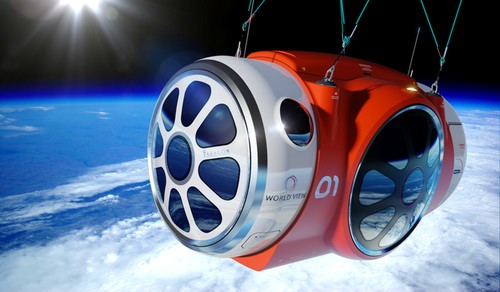 A closeup of the World View capsule. (credit: World View Enterprises) World View in funded for its current development phase, Poynter said, from sources like the VegasTech Fund and others involved in resorts. “We didn’t feel the need to go to the space or aerospace technology world for funding,” she said. “The luxury experience world is where a lot of our funding came from.”
The company is marketing the balloon flights on the experience of seeing the Earth from (near) space, offering views for far longer than possible on suborbital rocket-powered flights. “We want to be able give people access to the experience of seeing the Earth from space,” Poynter said, perhaps giving passengers the experience of the “Overview Effect” that many astronauts have experienced on orbital flights. MacCallum noted that James May, one of the stars of the British show Top Gear, found a high-altitude flight on a U-2 aircraft to be a particularly transformative experience, giving them confidence that the even higher and longer World View flights can have a similar effect on passengers.
The company doesn’t see itself in competition with Virgin, XCOR, or others planning rocket-powered suborbital flights that will go to altitudes of 100 kilometers or more and offer several minutes of weightlessness. In fact, Poynter and MacCallum believe the balloon flights may encourage people to then go on suborbital rocket flights. “I really think we’ll end up being a feeder, helping the other suborbital folks,” MacCallum said.
A company they will be in much closer competition with is Spanish company zero2infinity, which is planning similar high-altitude passenger balloon flights under the “bloon” name. That company is proposing slightly higher flights (to 36 kilometers) in a pressurized capsule that can carry four passengers and two pilots. (World View is initially planning to carry six passengers and two pilots, later going to seven passengers and one pilot.) Neither Poynter nor MacCallum said they knew enough about zero2infinity to comment on how they were different, but noted the presence of two companies offering similar experiences helped validate the market in the eyes of their investors.
For now, World View is working on smaller scale tests of the complete flight profile through early next year, after which they’ll move on to development of the full-scale system and tests that they expect will take two years. Commercial operations would begin in 2016 at the earliest, a schedule MacCallum acknowledged required everything in the development process to go smoothly. While the FAA determination specified Spaceport America in New Mexico as the launch site of the flights, the company is looking at multiple locations, perhaps rotating the system though several on a seasonal basis.
“I’m personally very excited about this,” said Poynter, who noted she would be cutting back on her responsibilities at Paragon to focus on World View. “We’re really bringing something new into this incredibly exciting time in commercial spaceflight.”
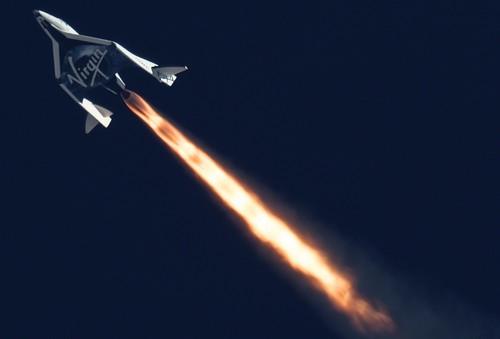 SpaceShipTwo flies on its second powered test flight on September 5. (credit: MarsScientific.com and Clay Center Observatory) The next powered test flight of Virgin Galactic’s SpaceShipTwo suborbital vehicle is coming up “very soon,” a top company executive said at a conference Thursday, as some observers continue to speculate about the reasons for the extended test program.
Virgin Galactic president Steve Isakowitz discussed the company’s test plans in response to a question during a panel session at the International Symposium for Personal and Commercial Spaceflight (ISPCS) in Las Cruces, New Mexico, on Thursday. (Disclosure: I moderated the panel; the question came from the audience.) “We have a series of them coming up very shortly,” he said of upcoming test flights. “We don’t normally announce our dates ahead of time, but I can tell you we have one that’s very soon that will also, again, incrementally build us up” to the point where SpaceShipTwo can fly into space.
SpaceShipTwo has performed two powered test flights to date. The first powered SS2 flight took place on April 29, when the vehicle fired its hybrid rocket engine for 16 seconds, achieving a top speed of Mach 1.3 and peak altitude of 16,800 meters (55,000 feet). SS2 made its second powered flight on September 5, firing the engine for 20 seconds, going to Mach 1.43 and 21,000 meters (69,000 feet) while also testing the vehicle’s feathering system needed for suborbital reentries. The long gap between those flights (and the lack of powered flights since then) has fueled in the space industry an undercurrent of rumors of issues with the vehicle’s engine.
Isakowitz, speaking at ISPCS, gave no hint of any issues with the engine, and noted that company’s customer base, now at 650 people, have been patient with the vehicle’s development delays. “We’ve generally found with our customers that they’re a heck of a lot more patient than the media or those in the industry,” he said. “From our customers, we really haven’t had anybody who’s said, ‘Forget it, you guys are taking too long.’ In fact, I don’t think we’ve lost a single person who’s said, ‘You’re simply taking too long.'”
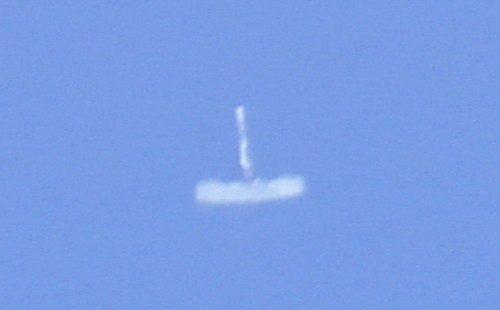 An image released by SpaceX of the Falcon 9 v1.1 first stage after reentry on its maiden flight, just three meters above the ocean. The stage was intact at the time, but broke up upon impact with the water. (credit: SpaceX) SpaceX is expected to complete its investigation into why the second stage engine on the Falcon 9 launched last month didn’t relight as planned, while the company also moves on from its Grasshopper reusable test vehicle, a company executive said this week.
Speaking at the International Symposium for Personal and Commercial Spaceflight (ISPCS) in Las Cruces, New Mexico, on Wednesday, SpaceX president and chief operating officer Gwynne Shotwell discussed the company’s most recent launch, the inaugural flight of the Falcon 9 v1.1 on September 29 from Vandenberg Air Force Base. While billed as an upgraded version of the original Falcon 9, she acknowledged that it was, in essence, a new launch vehicle. “We called it the version 1.1 to not scare anybody, but it’s really like the version 1001,” she said. “It was quite a different vehicle.”
While the launch was a success, placing the Canadian CASSIOPE space weather and technology demonstration satellite and several small secondary payloads into orbit, the vehicle’s second stage engine failed to relight after satellite deployment as a test. That failed relight attracted scrutiny from some observers, particularly after Air Force satellite tracking indicated the existence of a number of additional objects beyond the satellites and upper stage, which some interpreted as debris from the upper stage that may have been linked to the failed reflight.
Shotwell, talking to reporters after her ISPCS speech, said the investigation into the failed relight is nearly complete. “We should finish up on Friday,” she said, a timeline that would given insurers enough time to review the report before the company’s next scheduled launch, of the SES-8 commercial communications satellite, now planned for November 12. Unlike the CASSIOPE mission, the SES-8 launch, as well as another commercial communications satellite planned for launch in December, will require the second stage engine to relight to place the satellites into the proper geostationary transfer orbit.
Shotwell did not go into much detail about the cause of the failed relight, citing, among other issues, export control concerns. “We thought we knew right away,” she said. “It was something that we had seen previously on [version] 1.0 and we thought we had gotten completely away from it because, in fact, we obviously relit the second stage a couple of times on 1.0. But in this new configuration there were just a few things that maybe we should have done but didn’t.”
An update about the launch posted by SpaceX on its website earlier this week does offer some additional details. “The engine initiated ignition, with pressure rising in the thrust chamber to about 400 psi, but the flight computer sensed conditions did not meet criteria and it aborted the ignition,” the company stated. “SpaceX believes it understands the issue which didn’t involve anything fundamental, rather a need to iron out some of the differences between operating the engine on the ground versus in a vacuum.”
Shotwell, though, emphasized that the failed relight didn’t mean the launch was by any means a failure. “Let’s be clear: that mission was a success,” she said. “This flight was a complete success. We had no mission requirement to do a relight of the second stage, so it was a success.” Performing three successful flights, as determined by meeting all mission criteria, is a milestone required by SpaceX to be certified by the Air Force for future launches of military payloads.
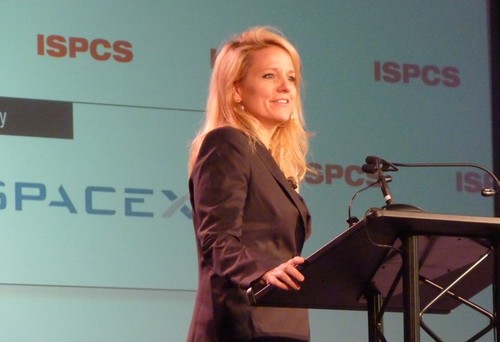 SpaceX president and COO Gwynne Shotwell speaking at the ISPCS conference in Las Cruces, NM, on October 16, 2013. (credit: J. Foust) Shotwell, in her speech and in talks with reporters, also discussed the next stage of the company’s efforts to develop reusable launch vehicle technology. The October 7 flight by the company’s Grasshopper test vehicle, where the vehicle went to an altitude of 744 meters before landing vertically, was the last planned flight of that vehicle by the company. SpaceX is now moving on to a full Falcon 9-R (“Falcon Niner”) first stage equipped with flight-weight, retractable landing legs, for test flights at Spaceport America in New Mexico starting in late December.
“The testing that we’ll be doing here in New Mexico will be of a flight stage,” she said, with the only difference being that the stage will lift off with its landing legs extended; there were no plans to test retracting and extending the legs, at least on the initial test flights. “We’re trying to make it as flight-like as possible.”
While SpaceX isn’t planning to fly Grasshopper again, Shotwell said there were no plans to do anything else with it. “We’ll do like all SpaceX things: we’ll hold on to it,” she said. She added she almost regretted still having Grasshopper intact after its series of tests. “In some ways we’ve kind of failed on the Grasshopper program because we haven’t pushed it to its limit,” she said. “We haven’t broken it.”
Grasshopper and the Falcon 9-R test vehicle are two of the company’s steps towards reusability. SpaceX also conducted a test of trying to recover the first stage on the Falcon 9 v1.1 launch last month, firing three of the first stage’s nine engines after stage separation as it reentered the atmosphere, and tried firing the the center engine again before landing. That second relight didn’t work well, though, because the stage was spinning fast enough (due to aerodynamic forces) to push the remaining propellant against the walls of their tanks, shutting off the flow of propellants to the engine.
In her ISPCS speech, though, Shotwell showed a photo taken of the first stage when it was just three meters above the ocean, immediately before splashdown. (That photo was also included in the SpaceX update on the launch). The stage was still “fully intact” at that time, she said, although “it didn’t remain intact after it hit the ocean” an instant later.
“We were so jubilant after the last flight” because of how close they came in recovering the first stage intact, she said. “Between the flights that we’ve been doing with Grasshopper and this demonstration, we’re really close to full and rapid reuse of stages.”
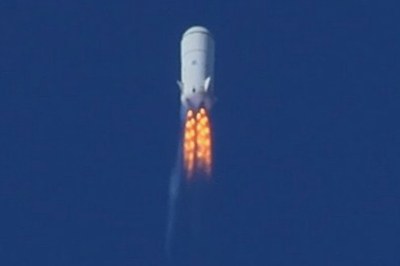 Blue Origin’s PM2 suborbital experimental vehicle, shown here on a flight before being lost during a test flight in August 2011. (Credit: Blue Origin) Blue Origin has developed a reputation over the years as a notoriously secretive company, only grudgingly releasing information about the company and its plans. While other companies hold high-profile events for media and customers (hi, Virgin Galactic!) or issue press releases about their ongoing efforts, Blue Origin only rarely issues releases or discloses information, which means those interested in the company hang on, and often try to parse, any words said by company leadership, including founder Jeff Bezos.
On Friday, Bezos did discuss Blue Origin in an on-stage interview Friday that was part of the grand opening of the Bezos Center of Innovation at Seattle’s Museum of History and Industry. As reported by Seattle technology publication GeekWire, Bezos said that the company was now up to 300 employees, the first time in recent memory the company has disclosed a headcount. That makes it small compared to SpaceX, which now has over 3,000 employees, but likely on a par with the Virgin Galactic/The Spaceship Company team developing SpaceShipTwo, and much larger than other suborbital companies like XCOR Aerospace and Masten Space Systems.
“The project is going extremely well,” Bezos said of the company’s efforts to develop suborbital and orbital reusable spacecraft, according to the GeekWire report. He said the company is working on its third iteration of its New Shepard suborbital vehicle, adding that he hopes this is the final iteration before beginning commercial service, although he didn’t offer a timetable for that.
Bezos regularly devotes time to Blue Origin, according to an excerpt of a new book about Bezos and his more famous company, Amazon.com, published in the latest issue of Bloomberg Businessweek. Author Brad Stone writes that Bezos “moonlights” a day a week at the company. (According to the book itself, The Everything Store: Jeff Bezos and the Age of Amazon, just published today, Bezos spends each Wednesday at Blue Origin.)
Blue Origin has also been working on an orbital vehicle concept that would launch initially on top of an existing rocket like an Atlas V, but eventually on the company’s own reusable boosters. The company got some funding and technical support from NASA under the Commercial Crew Development (CCDev) program, and although Blue Origin elected not to continue under the next funded phase of the program, Commercial Crew Integrated Capability, it has extended the Space Act Agreement it had under its CCDev-2 award to permit additional, unfunded cooperation with NASA. Bezos said that the company’s orbital vehicle would be ready for flights in 2018, according to the GeekWire report, but didn’t mention how it would be paid for given the lack of NASA funding.
Those orbital flights, though, would likely come well after the suborbital vehicle begins service. “We will be able to have tens, if not low hundreds of flights [suborbitally] to prove out that flight heritage before putting people in orbit,” Brett Alexander, director of business development and strategy, said at a conference on human spaceflight organized by the US Naval Institute and held at the Naval Academy in Annapolis, Maryland, earlier this month.
Blue Origin, of course, has also been locked in a controversy with SpaceX over their competing bids to lease Kennedy Space Center’s Launch Complex 39A; Blue Origin has proposed a multi-user commercial facility on the former shuttle launch pad while SpaceX originally sought an exclusive use agreement. SpaceX’s Elon Musk was openly skeptical of Blue Origin’s ability to use the launch pad any time in the next five years, telling Space News that “we are more likely to discover unicorns dancing in the flame duct” of the pad than Blue Origin showing up with an orbital spacecraft to launch in the next five years.
However, Blue Origin has famously also taken the long view, not surprising for a company with the motto “Gradatim Ferociter” (roughly translated as “step by step, with ferocity”). Other than the $25.7 million it received from NASA, Alexander said the rest of the company’s funding has come from Bezos, accounting for “well more than 90 percent” of the company’s total investment so far (suggesting a total investment of well more than $250 million), and that this would continue for the foreseeable future.
“Fundamentally, we are on a journey that is about changing spaceflight from being dangerous and expensive into something that’s accessible to a broader sector of humanity,” Alexander said. “We view it as a long-term endeavor, something that’s 20, 30, 40 years in the making.”
And for the secrecy? “I think the reality is that we’re just very quiet,” Alexander said. “We like to talk about things after we’ve done them, and not before that, and hopefully you’ll be hearing a lot from us in the future.”
|
|










Recent Comments